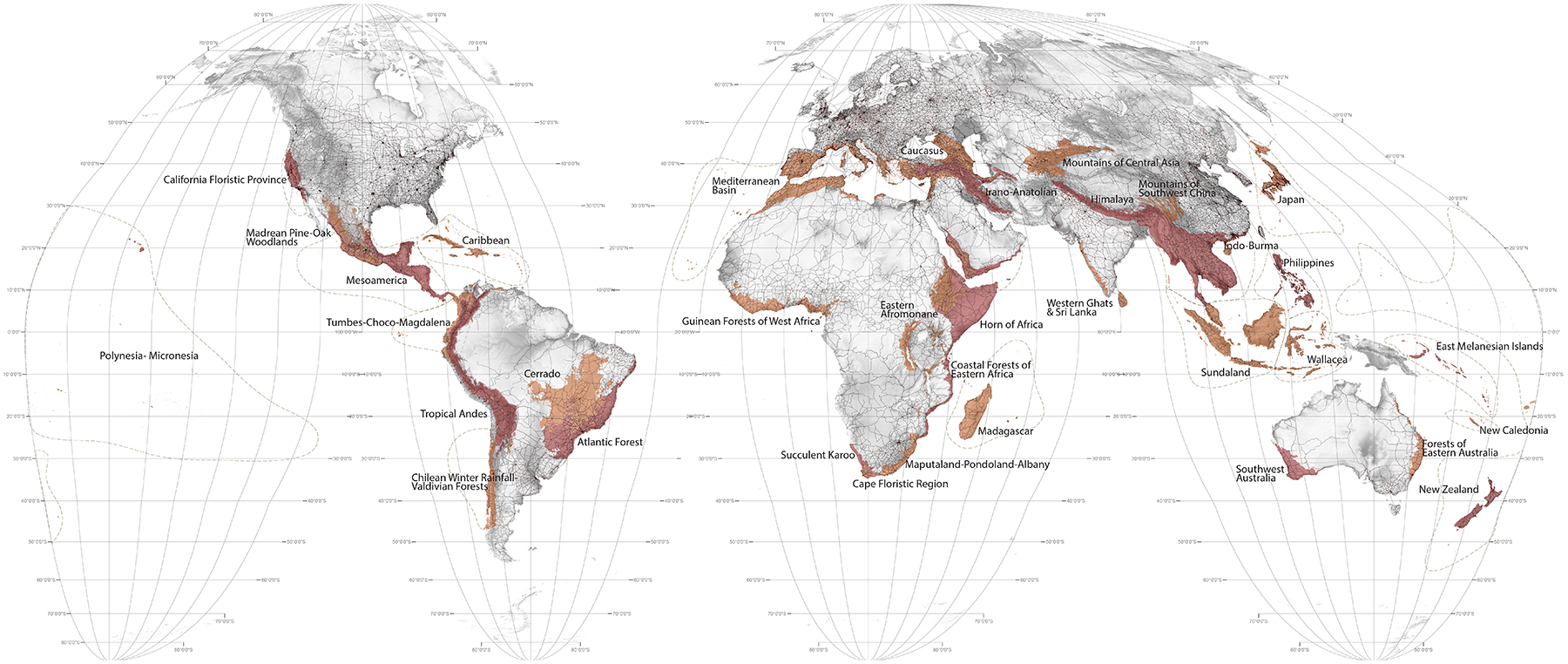Biodiversity hotspots are defined as areas "[h]aving at least 1500 endemic plant species and having lost at least 70 per cent of their original habitat extent". 1 Together, the world's hotspots contain at least 50% of the world's total plant species and 42% of the world's terrestrial vertebrates as endemic. Originally representing 16% of the Earth's surface, the unique habitat of the hotspots has diminished to just 2.3%. 2 Consequently, conservation funding, research and activism have primarily focused on the urgency of preserving this remaining biodiversity to reduce the risk of extinction of "more than half of our natural heritage." 3 Comprising 70% of the world's known languages, many of which are predicted to disappear by century's end, the hotspots are also remarkable for their cultural diversity, a vital clue perhaps, to our intertwined fates. 4
There are 142 nations under whose jurisdiction the hotspots collectively fall. As this atlas shows 14 of the hotspots have reached or surpassed the Convention on Biological Diversity's (CBD) 2020 terrestrial protected area target of 17% (IUCN categories I-VI, plus NA lands), and 21 have not. However, the protected areas are also supposed to be representative of a nation's different ecoregions. The hotspots comprise 391 ecoregions and of these, only 170 have reached or surpassed the 17% target (IUCN categories I-VI, plus NA lands). 221 have not.
There are 422 major cities in the hotspots (over 300,000 inhabitants), 383 of which are forecast to sprawl into extant, high biodiversity habitat.
1 Russell A. Mittermeier, et al., Hotspots Revisited: Earth's Biologically Richest and Most Endangered Terrestrial Ecoregions (Washington, DC: Conservation International and Cemex, 2004).
2 NB these figures are from Mittermeir, Hotspots Revisited... Hence they do not include the 35th and 36th designated hotspot of the Forests of East Australia which was added in 2010 and the North American Coastal Plain which was added in 2016.
3 Mittermeir, Hotspots Revisited, 37.
4 This figure includes areas of 'high biodiversity wilderness in addition to the hotspots. See Larry J. Gorenflo, et al., "Co-occurrence of Linguistic and Biological Diversity in Biodiversity Hotspots and High Biodiversity Wilderness Areas," Proceedings of the National Academy of Science 109, no. 21 (2012): 8032-8037.
1. Hotspots
Critical Ecosystem Partnership Fund, "The Biodiversity Hotspots," http://www.cepf.net/resources/hotspots/pages/default.aspx (accessed July 1, 2014). Data made available under the Creative Commons BY-SA 4.0 License: https://creativecommons.org/licenses/by-sa/4.0/legalcode.
